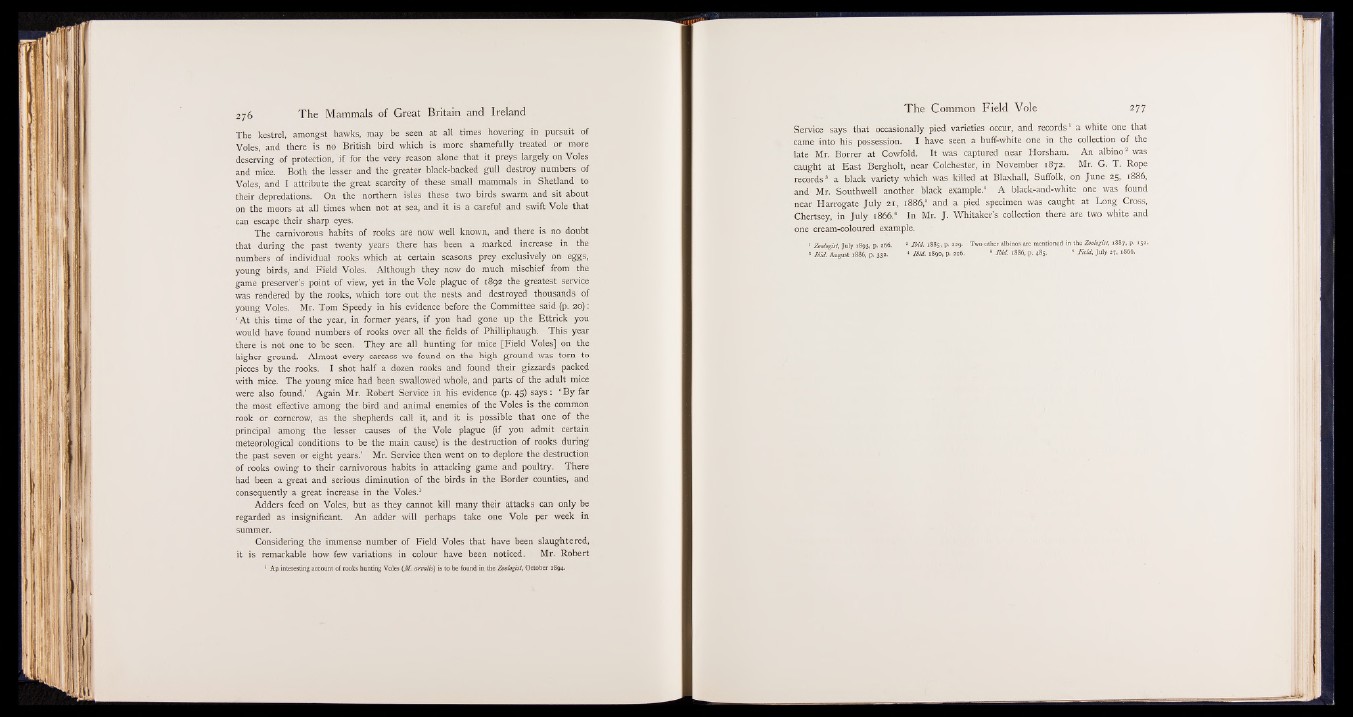
The kestrel, amongst hawks, may be seen at all times hovering in pursuit of
Voles, and there is no British bird which is more shamefully treated or more
deserving of protection, if for the very reason alone that it preys largely on Voles
and mice. Both the lesser and the greater black-backed gull destroy numbers of
Voles, and I attribute the great scarcity of these small mammals in Shetland to
their depredations. On the northern isles these two birds swarm and sit about
on the moors at all times when not at sea, and it is a careful and swift Vole that
can escape their sharp eyes.
The carnivorous habits of rooks are now well known, and there is no doubt
that during the past twenty years there has been a marked increase in the
numbers of individual rooks which at certain seasons prey exclusively on eggs,
young birds, and Field Voles. Although they now do much mischief from the
game preserver’s point of view, yet in the Vole plague of 1892 the greatest service
was rendered by the rooks, which tore out the nests and destroyed thousands of
young Voles. Mr. Tom Speedy in his evidence before the Committee said (p. 20):
‘ At this time of the year, in former years, if you had gone up the Ettrick you
would have found numbers of rooks over all the fields of Philliphaugh. This year
there is not one to be seen. They are all hunting for mice [Field Voles] on the
higher ground. Almost every carcass we found on the high ground was torn to
pieces by the rooks. I shot half a dozen rooks and found their gizzards packed
with mice. The young mice had been swallowed whole, and parts of the adult mice
were also found.’ Again Mr. Robert Service in his evidence (p. 45) sa y s : ‘ B y far
the most effective among the bird and animal enemies of the Voles is the common
rook or corncrow, as the shepherds call it, and it is possible that one of the
principal among the lesser causes of the Vole plague (if you admit certain
meteorological conditions to be the main cause) is the destruction of rooks during
the past seven or eight years.’ Mr. Service then went on to deplore the destruction
of rooks owing to their carnivorous habits in attacking game and poultry. There
had been a great and serious diminution of the birds in the Border counties, and
consequently a great increase in the Voles.1
Adders feed on Voles, but as they cannot kill many their attacks can only be
regarded as insignificant. An adder will perhaps take one Vole per week in
summer.
Considering the immense number of Field Voles that have been slaughtered,
it is remarkable how few variations in colour have been noticed. Mr. Robert
1 Ap interesting account of rooks hunting Voles (M . arvalis) is to be found in the Zoologist, October 1894.
Service, says that occasionally pied varieties occur, and records1 a white one that
came into his possession. I have seen a buff-white one in the collection of the
late Mr. Borrer at Cowfold. It was captured near Horsham. An albino* was
caught at East Bergholt, near Colchester, in November 187,2. Mr. G. T. Rope
records8 a black variety which was killed at Blaxhall, Suffolk, on June 25, 1886,
and Mr. Southwell another black example.4 A black-and-white one was found
near Harrogate Ju ly 21, 1886,8 and a pied specimen was caught at Long Cross,
Chertsey, in July 1866.5 In Mr. J . Whitaker’s collection there are two white and
one cream-coloured example.
1 Zoologist, July, 1893, p. 266. 2 Ib id . iS8 |lp. 353. Two othrr uiSiuos are ir.or.liontd in the Zcalegist, 1887, p. 15a,
8 Ib id . August 188G, p. 332. 4 Ib id . 1890, p. 216. 8 Ibid. 1SS6, p. 485. 8 F ield , July 27, 1866.